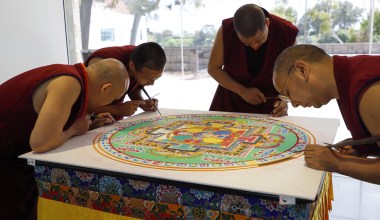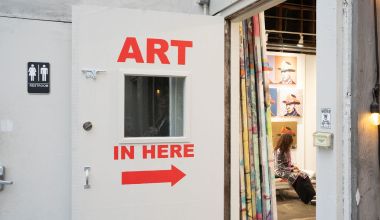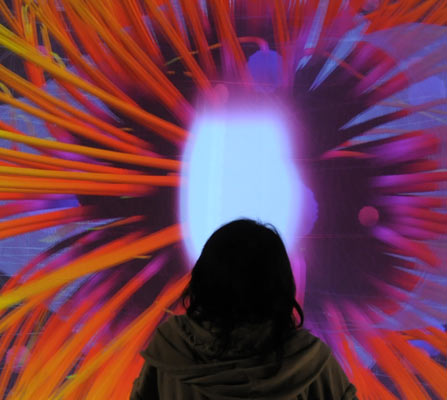
Take a little ride with me, now, from downtown into a lattice of atoms.
First head north on 101 to Ward Memorial, then west under the Henley Gate, past the new pre-postmodern mural, and deep into the University of California at Santa Barbara. Park the hybrid car in Lot 10, and don’t forget to pay the machine as we take our first step into the unexpected.
Hark here the new Mall of Academe!
Observe the absence of those old army bungalows. They’ve tarted up the science end of campus nice now after millions poured into research coffers, especially since Chancellor Henry Yang-an engineer himself-began emphasizing the sciences with vigor. See this little confluence of science shops surrounding picnic tables, a food court, and open-air views of the airport and the slough. Over there’s the Kavli Institute for Theoretical Physics (Nobelists on board!), the Bren School of Environmental stuff, the engineering place where blue-laser guru Shuji Nakamura hangs, and our final destination: the California Nanosystems Institute in Elings Hall, home to electron microscope and haptic technology (where you can feel the tug of a molecule’s bonds), with warnings and showers and those as-seen-on-TV blackboards really filled with chalk equations. Up on floor two is the Media Arts and Technology (MAT) graduate program, where we now follow the Xeroxed paper signs: This Way to the Allosphere.
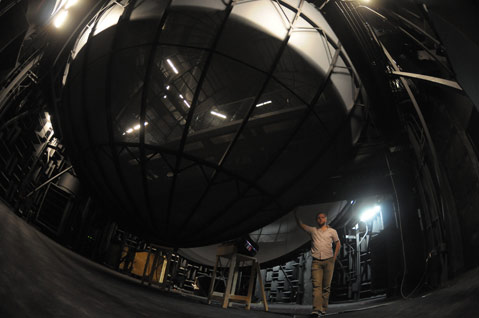
“There’s nothing like it in the world,” says host JoAnn Kuchera-Morin, the brain-parent of this enormous round room, this gateway to immersive media experiential bliss. She’s not exactly right-there have been large immersive theaters since the early 1990s-but the Allosphere is both more immersive and less subjective, according to its proponents, as you will soon see.
After swiping a security card, we come into a darkened room where eyes grow used to the gloom first, and then to the wonder. X-Men fans may experience dej vu here-it’s a gangplank bisecting a giant sphere, la Professor X’s thoughtful spot Cerebro. Walking out, I grasp the railing nervously and, suddenly, on the screen to the right, a swarm of colorful, platelet-shaped lozenges dance to the sound of bubbly electronic music.
“You’re doing that, by the way,” laughs our host, “by touching the handrail.” That makes me jump. “It’s okay,” she says, but by then she’s into a litany of Allosphere logistics: three stories high, 2,000 square feet, engineered by sonic wizards to be acoustically neutral, making the sound in this round chamber equally good at any wavelength, anechoic. Right now, 16 four-inch speakers surround us, though eventually there will be 512. The sphere has two curved screens, suspended like floating mists in the semi-gloom. Only one side is currently operational, but soon spectators will be completely bombarded by sounds and sights of physical phenomena projected front and rear via supercomputer. All told, it’s $5 million of erected flash technological accomplishment, with another $5 million needed to get it all the way up.
“Now, I’m going to fly you in there,” she says, handing me a $600 pair of 3-d glasses while grabbing a joystick. And in we sweep.
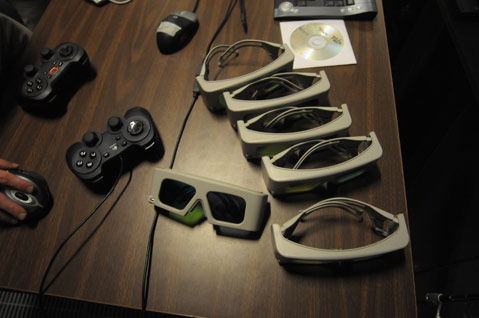
It’s appropriate that the first thing Kuchera-Morin shows me is the inside of a professor’s brain: namely the thinking organ of Marcos Novak, who describes himself as a “pioneer in virtual architecture,” but who also coined many terms that MAT students gleefully plug into conversations-“transvergence” for instance, or “transarchitecture.” The brain of Novak, who also named the Allosphere, was earlier captured by an MRI machine that measured changes in his blood density while he watched videos of contemporary abstract art and examined them for balance, symmetry, and other psycho-aesthetic combinations not connected to realistic imagery such as people or puppy dogs. That makes Novak and his friends “the first artists to quantify beauty,” believes Kuchera-Morin.
Despite the danger of exciting the bubbly lozenges, I hang on while diving through the depths of Novak’s noggin. Crags, shelves, and deep abysses open, coursing through inner space, colors rushing past either side of us like the psychedelic astronauts from 2001: A Space Odyssey. Tints help delineate the occipital from the parietal or temporal lobes. All of this imagery is from data recorded, laid out in grids, and then colored in by computer operators-accurate on the one hand, visually resplendent on the other. (I’m for sure leaning more to Stanley Kubrick than Fantastic Voyage.)
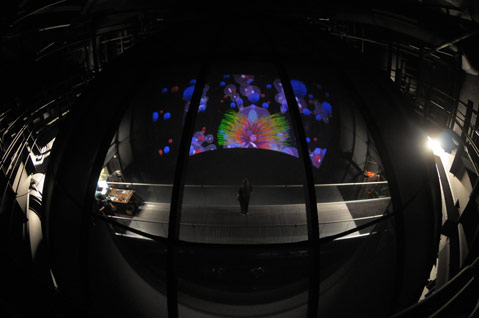
Kuchera-Morin coaxes me back to the railing. “Put your hand back on there,” she demands, explaining that the lozenges represent blood, and have been sonified-given tonal values that make warbling electronic melodies. “Now, it’s going to sing its song,” she explains. Swarming forth, Novak’s representational blood makes music.
As psychedelic as it seems, the Allosphere isn’t just a simulated acid trip in a big weird machine. It’s metaphorical, too, nicely representative of the new world at UCSB, which began as a little liberal arts college in the late 1950s but is now a place where disciplines collide, where scientists and artists meet, where chemists win Nobel prizes for physics and vice versa. In fact, the Allosphere’s costly hyperbole just might be the best face UCSB has ever had.
And it isn’t just a theater, either. To Kuchera-Morin and her students, it’s a big experimental field, ready to play on. “We’re not designing virtual reality,” Kuchera-Morin explains, as we get started. “In here, we’re designing reality.”
The Musician from Monongahela
She may seem a little science-nerdy, but Kuchera-Morin is mostly about the music, and thus her road to the Allosphere seems unlikely. Born in 1953 in Monongahela, a small Pennsylvanian mining town near Pittsburgh, her family moved to Florida “to live the modern life. I can remember when my mother discovered beans in the can.” It was a blue-collar upbringing, which did not include the arts beyond stints in the choir.
Yet Kuchera-Morin, against impossible odds, got into the Eastman School of Music, where she studied composing and was caught between the au courant John Cage torturing of instruments and a love of great performances. That led her to an almost chance epiphany about computer music, where instrument and performance became one. “We were like a bunch of apes gathered around the monolith,” she laughed, speaking of her peer group encounter with the digital possibilities. Somehow this unlikely string of events landed her a teaching post at UCSB-not in the music department, but in engineering. “They had all these people from Stanford, from MIT, and they hired me! A composer from Eastman. All these glorious blunders!”
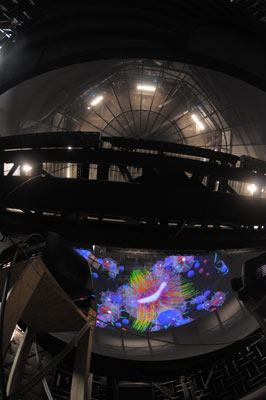
Short with shoulder-length graying hair, more like a friendly Disney witch than a prof, Kuchera-Morin’s monologues are as immersive as an Allosphere presentation, mixing scientific discourse with something richly felt-let’s call it passion. Her words tumble out, lucid and learned, though often interspersed with comic spurts of exasperation.
Take, for instance, her memory of discovering computer languages: “That was an eye-opener to me, when I had that computer in my hand and I realized, ‘God! Anybody can put their information into this machine and it comes out zeroes and ones-what does that mean?’ : [In music school], they never get into acoustics or the psycho-acoustics of the ramifications of vibrations of the first overtone partials of the instrument. But then with the computer, you realize, ‘Oh my God! It’s all math.’ They never explained to me-that it’s all math. So you start to understand that the tradition of music is so interesting because here you have hundreds of years of writing this notation that’s an abstraction of all of these mathematical principles and constructs that you don’t even get to. : And yet the language is so incredible, to be able to write music, to write notation when you try to decode that into time? All those notes? It’s incredible the complexity. :These are things I was learning in the ’80s with a new technology that was coming in. In the early days, we were pulling apart everything.”
She began haunting the UCSB engineering department exploring these conversions. “At first, they thought I was crazy,” she laughed, describing those she approached trying to develop the first digital-audio computer systems, which then did not exist. “I was trying to convert numbers into sound, and they said to me, ‘Why would you want to do that?’ Then I told them I wanted to use computers for visual art, and they said, ‘Are you crazy? Computers are just for crunching numbers.'”
During an international computer music conference in 1987, Kuchera-Morin created believers when she nervously explained her projects to a room of scientists and unexpectedly brought down the house. From there, she traversed a number of high-profile posts, including dean of information technology and computer science at UCSB’s College of Letters and Science and a leadership role in bridging the University of California campuses under Governor Gray Davis, who generously gave the system $300 million to encourage the crossing of campus and departmental boundaries.
When Kuchera-Morin approached UCLA to cosponsor a project with UCSB that bridged arts and technology, the schools won a $100 million grant, which underwrote the California Nanosystems Institute, MAT, and the Allosphere. Today, Kuchera-Morin is the director of the Allosphere, director of the Center for Research in Electronic Art Technology, and a professor at MAT-not bad for a composer from Monongahela.
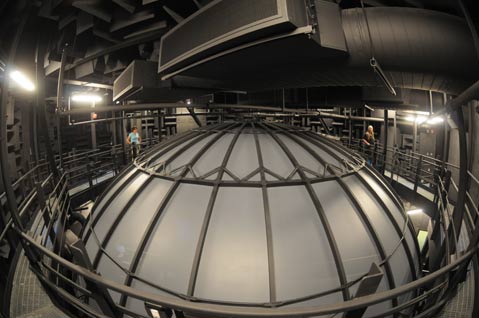
Quantum Entanglements
But what about that promised lattice of atoms, you ask?
“Mostly, this is about taking you where you can’t go,” explained Kuchera-Morin, whose second Allosphere installation involves something even smaller than the inside of a cranium: a multicentered hydrogen bond, which the MAT crew put together at the request of materials engineering wizard Christopher Van de Walle.
As with the brain, Kuchera-Morin said they began by being “agnostic to the data.” In other words, this is not an artist’s rendering, not a cartoon version of Mr. Molecule’s Adventures. Instead, it’s an interpretation of what these quantum flotsam would look like interacting given certain properties-you know, like Schrdinger’s theories about quantum superpositions and the Heisenberg principle, stuff like that. MAT gets the equations and the computer tells the Allosphere projectors how these things would behave based on real physical theories and laws. Wandering in for the first time, Van de Walle’s researchers stepped back in awe. “Look!” said the engineers to each other, while watching the realistically reacting particles. “I told you that’s what would happen.”
Tootling the joystick-an adapted Nintendo Wii controller-Kuchera-Morin takes me diving into the atomic storm, the colors, again, astounding, sounds filling the room. She’s assigned each color a tone that signals its identity and offers aural pleasures. Though not happy that science has cut into her music-making time, Kuchera-Morin still finds inspiration for her musical palette-currently she’s composing a “Quantum Entanglement Symphony.” You can see why as we rush through colors and shapes, and they rush past us. Then, as Kuchera-Morin speaks, she starts muttering something about the control lever and wonders what she can do to make our dive through the lattice more dramatic. She grunts a little and suddenly we’ve rushed past the data, beyond the images, into empty space. “Whoops,” she said. “Wonder how I get us back.”
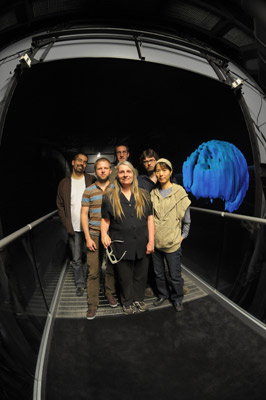
In the meantime, two MAT grad students have joined us up on the catwalk. Basak Alper-a computer engineer/PhD program participant from Istanbul who specializes in information visualization and human/computer interaction-takes the joystick and deftly renegotiates the three-dimensional terrain filling my head with quantum physics. Then, Wesley Smith, who looks more like an indie musician than a code writer, chimes in. After some time, he eventually cedes to the happily voluble Kuchera-Morin, who’s led herself onto a metaphysical level explaining why it would be better to listen to King Crimson than the Grateful Dead while flying the ‘sphere. She seems to be suggesting a quantum Buddhism might be found. The students smile indulgently.
Alper and Smith are some of the roughly 40 grads whom MAT trains at any given time, split evenly between masters and doctoral students. The first ones arrived in 1999 to take advantage of, as the catalogue succinctly states, “an unparalleled opportunity for working at the frontiers of art, science, and technology, where new art forms are born and new expressive media are invented.” The faculty is mostly artists working extensively with computers or employing other technological modes of expression, and the requirements, course work, and publishing requirements are no joke.
The pioneers include our brain buddy Novak, a highly provocative virtual architecture artist with a campus reputation for swagger; Jean-Pierre Hebert, an artist who draws using code and is just ending a one-person exhibition at the Contemporary Arts Forum; and George Legrady, who is just beginning one at the newer Edward Cella Art + Architecture and uses NASA data in his installations. Students can attach themselves across disciplines, and that’s the idea. “Our students are famous,” said Kuchera-Morin, citing numerous recent exhibitions and performances from China to Los Angeles. “They’re learning the different cultures well. They publish scientific papers together, and some of the engineering students are giving their first shows. What we are doing is creating a new kind of hybrid student.”
So what’s that mean? “It’s going to take us another 20 years to figure out exactly where this will go,” explained the composer, but she’s in no rush. “We’re not sure, okay? We’re happy to be discovering ourselves. We don’t exactly want to be confined. Look what happened to computer science, for instance. Fifty years ago, people were asking, ‘What is this thing, a cross between engineering and sociology?'” Today, computer science is a wildly popular major rigidly taught in codified cirriculum. But make no mistake: Kuchera-Morin enjoys the mystery and likes MAT at its current crossroads.

Critical Mass
For a program equal parts obscure and expensive, there are surprisingly few Allosphere critics. There’s the knee-jerk-or, perhaps, morally justified-outrage at the cost alone, and some voices raised in private against the use of data in such an overwhelmingly huge container, the idea being that you can explore the links between art and science on a little laptop as well as you can inside this big dramatic sphere.
And then there are some who have chosen to attack it on an aesthetic level, though, again, no one wanted to go on the record. One arts professor waggishly referred to it as “the orgasmatron from Woody Allen’s Sleeper,” yet remains intrigued by possibilities. “I saw an exhibition of Curtis Roads’s students work,” said one arts advocate, speaking of a faculty member famous for computer music. “And I just think it isn’t very good art. There’s nothing human in it, and that’s what makes computer art real art: a human touch, which was not in this show.”
But the MAT students are open about artistic achievements. Smith, one of the students who drove me through quantum-space, is a 25-year-old PhD student who writes software for the machine. One recent Friday afternoon, Smith and his fellow students took me into a lab next door to the Allosphere to show off a program that translated the user’s touch on a laptop mouse into exploding balls of color and sound on a giant screen. (This group has also given exhibitions at an experimental arts studio in Santa Barbara’s Funk Zone, and Smith also put together a dance and computer piece for a recent S.B. Museum of Art Nights show.) Smith admits that the gorgeous colors aren’t humanistic. “What’s interesting about the animation conferences I attend is the complete lack of abstract animation that’s going on now,” he explained. “It wasn’t like that when computer animation began.”
Considering the scope of funding for the Allosphere on a campus where the competition for research monies is often cutthroat, the institutional complaints amount to wistful wishes MAT would’ve tied the project closer to the arts side of the campus, which often goes begging when compared to the heavily endowed sciences. Years ago, Film & Media Studies professor Constance Penley asked Kuchera-Morin to be part of the Center for Film, Television, and New Media, which is currently under construction. Given the large amount of money Penley raised for the center, some have pointed out that Kuchera-Morin, who still needs to raise about $5 million to finish the Allosphere, should have accepted the offer. Unlike many of the cash-strapped art departments, Film & Media Studies has acquired plenty of money through Penley’s fundraising, including gifts from celebrity donors such as Marcy Carsey (Roseanne, The Cosby Show) and CSI producer Dick Wolf. Kuchera-Morin declined, but she’s not harboring regrets either. “I think [Penley’s center] will be great,” she said. “But what they’re interested in is the theoretical end of media.”
MAT, on the other hand, is scientific, and Kuchera-Morin wants the Allosphere to balance ideas with their actual physical crystallizations. The department and device aren’t just for prompting intellectual discussions and devising umbrella theories on the ways that art and science can coexist, but instead to promote the manifestation of that interaction, to display visually and experientially that convergence and to share it with others. During my Allosphere exploration, I kept remembering being a high school sophomore who hated geometry until the teacher forced us to imagine the idea of a line as something that stretches to infinity in either direction-nicely mind-blowing. Yet springing from this universe of pure thought, geometry is the most practical of disciplines, used for millennia, in both Egyptian pyramids and Chrysler buildings. From the abstract notion, then-or, perhaps, from the right trip in the Allosphere-emerges a practical understanding of science and reality.
But MAT wants the Allosphere to be ambidextrous in technology and aesthetics, too, tapping into the way the arts have been transformed by science-think Pixar animation or Thomas Pynchon novels or the latest wave of 3-d digital movies that’ve been playing at the Arlington. The Allosphere teeters between simply visualizing data for scientists and creating overwhelming spectacles for a world of young people who grew up taking for granted big special effects, video games, and the Internet’s instant gratifications. All that said, Kuchera-Morin actually seems happiest just playing with atoms and cranial tissue, transferring ones and zeroes from a computer into a bubble with great speakers. “There’s beauty in truth,” Kuchera-Morin said. “If people don’t see it as beautiful, well, that’s a matter of taste.”
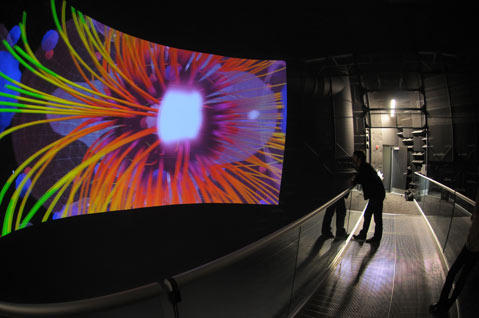
The Truth Machine?
The bottom line may never be reached, here. For one thing, new technologies come along faster than abilities to fund the existing ones into perfection. The Allosphere, for instance, is just the latest in immersive theater, which has been around since the first CAVE, or Cave Automatic Virtual Environment, was invented at the University of Illinois at Chicago.
CAVEs are now at many universities worldwide, include UC San Diego, where lecturer Brett Stalbaum has worked with such technologies for more than a decade. “There are many 3-d immersive environments of its type,” he told me of the Allosphere, although he did admit that UCSB’s version is pushing the boundaries of size, shape, resolution, and audio capabilities. But with technology moving so fast, people-including one prominent media critic at UCSB-are wondering aloud whether the $5 million funding Kuchera-Morin still needs will arrive in time to beat somebody else’s immersive bijou machine.
So why bank on the Allosphere? Why should the State of California and other entities fund a foray into immersive theater-making even if the “films” shown are scientific representations of human brains and molecular bondings?
Kuchera-Morin isn’t insensitive to the issue, agreeing, “It’s a good question: What is the point of all of this?” One answer is that the crazy machine is a perfect outreach tool, a means of revealing in an entertaining way all of the cutting edge-though often obscure and overly technical-research going on at UCSB. She explained, “One of the things that the Allosphere can do is make the things we do in this Ivory Tower clear to the community that surrounds us.”
Another positive spin is the metaphorical one-that the project reflects the university’s system-wide obsession with interdisciplinary approaches, and that the Allosphere helps keep UCSB creditably ahead of this curve. “This is why I stayed, why I love this place,” said Kuchera-Morin. “It’s a place where artists, scientists, and engineers can come together to look for the truth-in math.”
That’s still a bit academic, so Kuchera-Morin goes one step further, positing that the ‘sphere is reflective of the state of the Golden State. “I think we should look at California and the variety of industries that we see around the state,” said Kuchera-Morin. “It’s all here, from bioengineering to communications. There are movie studios and new media. This building captures all of these areas.”
And if that’s not enough, there’s always my favorite escape, fantastic cinema. “There are a number of people in Hollywood interested in this,” admitted the composer from Monongahela, who’s hosted some already. “There’s a lot of interest in curved screens, and there are at least three big 3-d theaters-one in Dubai-being built, and 184 planetaria are looking into immersive theater like this. Oh yes, Hollywood is very interested.”
But the MAT students are probably the real future of this project. I asked Smith how many shows the Allosphere was currently able to run and he looked at me quizzically: “Shows?” It’s clearly more than a moving-picture exhibition to him and his fellow students, who benefit most from the flexibility of their studies. MAT offers connections to art, architecture, data retrieval, and multimedia signal-processing analysis, not to mention the “normal” curricula provided by the physics, engineering, and even English literature departments. The students spin your head in conversation, and are sure to keep on spinning to career success and cultural significance.
On one of my last visits to Elings Hall, I watched two students exhibit work more indebted to physics theorems than anthropomorphic animals. It reminded me of the Allosphere’s balance. I asked MAT doctoral candidate Lance Putnam about his work’s relationship to the sometimes cryptic world. “Not everything we do is experimental,” he explained. “I’m not here trying to prove facts about nature. At the end of the day, I’m just trying to create something interesting-though I admit, in the meantime, nature does seem to be getting stranger and stranger.”
He’s very pleased with the Allosphere as a tool, and not defensive about its ostentatious price tag. “The Allosphere is a lot like a microscope,” said Putnam, expressing hope. “We don’t know what we’re looking for until we see it.”
4•1•1
For more information on the Allosphere, see mat.ucsb.edu/allosphere.

